Bioc0001 practicals Study guides, Revision notes & Summaries
Looking for the best study guides, study notes and summaries about Bioc0001 practicals? On this page you'll find 8 study documents about Bioc0001 practicals.
All 8 results
Sort by
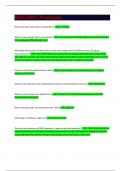
-
BIOC0001 Practicals
- Exam (elaborations) • 23 pages • 2024
- Available in package deal
-
- £10.08
- + learn more
How many base pairs long is a typical gene? - ANS ~10^4bp. What is supercoiling? What is its purpose? - ANS The twisting of a DS DNA helix around itself allowing it to be packaged efficiently into a cell. Why might two sections of DNA which are the same length travel at different rates during gel electrophoresis? - ANS Some of the DNA, but not all, becomes relaxed during laboratory preparation (the state of a circular, non-supercoiled plasmid). Some of the DNA remains supercoiled and so is ...
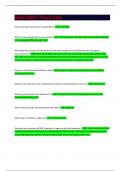
-
BIOC0001 Practicals
- Exam (elaborations) • 23 pages • 2024
- Available in package deal
-
- £10.08
- + learn more
How many base pairs long is a typical gene? - ANS ~10^4bp. What is supercoiling? What is its purpose? - ANS The twisting of a DS DNA helix around itself allowing it to be packaged efficiently into a cell. Why might two sections of DNA which are the same length travel at different rates during gel electrophoresis? - ANS Some of the DNA, but not all, becomes relaxed during laboratory preparation (the state of a circular, non-supercoiled plasmid). Some of the DNA remains supercoiled and so is ...
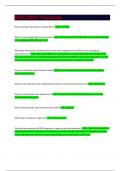
-
BIOC0001 Practicals
- Exam (elaborations) • 23 pages • 2024
-
- £10.24
- + learn more
How many base pairs long is a typical gene? - ANS ~10^4bp. What is supercoiling? What is its purpose? - ANS The twisting of a DS DNA helix around itself allowing it to be packaged efficiently into a cell. Why might two sections of DNA which are the same length travel at different rates during gel electrophoresis? - ANS Some of the DNA, but not all, becomes relaxed during laboratory preparation (the state of a circular, non-supercoiled plasmid). Some of the DNA remains supercoiled and so is ...
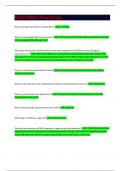
-
BIOC0001 Practicals
- Exam (elaborations) • 23 pages • 2024
-
- £10.89
- + learn more
How many base pairs long is a typical gene? - ANS ~10^4bp. What is supercoiling? What is its purpose? - ANS The twisting of a DS DNA helix around itself allowing it to be packaged efficiently into a cell. Why might two sections of DNA which are the same length travel at different rates during gel electrophoresis? - ANS Some of the DNA, but not all, becomes relaxed during laboratory preparation (the state of a circular, non-supercoiled plasmid). Some of the DNA remains supercoiled and so is ...
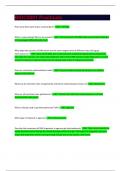
-
BIOC0001 Practicals
- Exam (elaborations) • 23 pages • 2024
-
- £10.32
- + learn more
How many base pairs long is a typical gene? - ANS ~10^4bp. What is supercoiling? What is its purpose? - ANS The twisting of a DS DNA helix around itself allowing it to be packaged efficiently into a cell. Why might two sections of DNA which are the same length travel at different rates during gel electrophoresis? - ANS Some of the DNA, but not all, becomes relaxed during laboratory preparation (the state of a circular, non-supercoiled plasmid). Some of the DNA remains supercoiled and so is ...
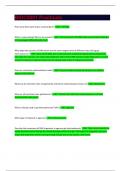
-
BIOC0001 Practicals
- Exam (elaborations) • 23 pages • 2024
- Available in package deal
-
- £12.49
- + learn more
How many base pairs long is a typical gene? - ANS ~10^4bp. What is supercoiling? What is its purpose? - ANS The twisting of a DS DNA helix around itself allowing it to be packaged efficiently into a cell. Why might two sections of DNA which are the same length travel at different rates during gel electrophoresis? - ANS Some of the DNA, but not all, becomes relaxed during laboratory preparation (the state of a circular, non-supercoiled plasmid). Some of the DNA remains supercoiled and so is ...
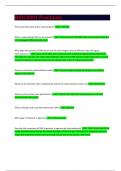
-
BIOC0001 Practicals
- Exam (elaborations) • 23 pages • 2024
-
- £10.48
- + learn more
How many base pairs long is a typical gene? - ANS ~10^4bp. What is supercoiling? What is its purpose? - ANS The twisting of a DS DNA helix around itself allowing it to be packaged efficiently into a cell. Why might two sections of DNA which are the same length travel at different rates during gel electrophoresis? - ANS Some of the DNA, but not all, becomes relaxed during laboratory preparation (the state of a circular, non-supercoiled plasmid). Some of the DNA remains supercoiled and so is ...

-
BIOC0001 Practicals
- Exam (elaborations) • 23 pages • 2024
- Available in package deal
-
- £12.49
- + learn more
How many base pairs long is a typical gene? - ANS ~10^4bp. What is supercoiling? What is its purpose? - ANS The twisting of a DS DNA helix around itself allowing it to be packaged efficiently into a cell. Why might two sections of DNA which are the same length travel at different rates during gel electrophoresis? - ANS Some of the DNA, but not all, becomes relaxed during laboratory preparation (the state of a circular, non-supercoiled plasmid). Some of the DNA remains supercoiled and so is ...



